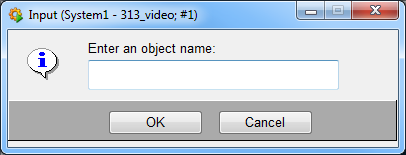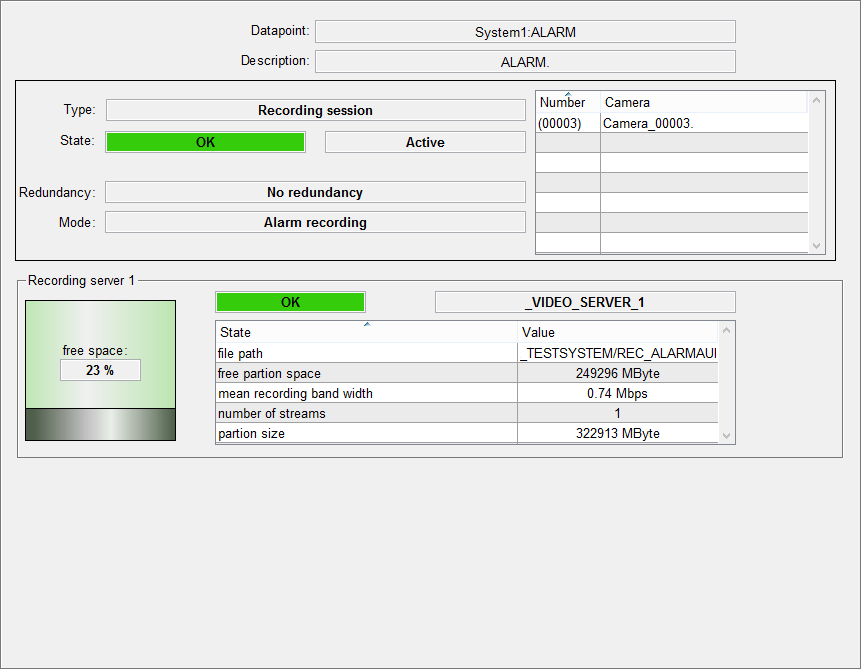Recording
The recording of video streams is possible via an internal recording system. The number of operated recording servers is scalable and can be increased on demand. Moreover, a redundant recording is also possible.
Configuration of the recording servers
Each host which shall be available as recording server must have a video server or recording server installation. Additionally the host must be configured as recording server. If the recording server shall have an video interface, it must be specified during the host configuration. The video servers automatically have a video interface.
Creating a new recording
Click on Recording with the right mouse button and select create new object. The following window is opened:

After entering the recording name the configuration panel will be opened.

Basic settings
The type of recording, the recording hosts and recording path (must always be the absolute path of the respective host) are defined here. The following recording types are available:
Please note that a stand-alone recording server requires a configuration via AccVimaccConfig.conf (under C:\vimacc\config)
Additional information on the AccVimaccConfig.config can be found here.
- No redundancy
- The recording is done on only one host
- Load balancing
- Both recording hosts automatically distribute the recording load. If one host fails, the other one takes over the whole load.
- Replication redundancy
- Each stream is recorded on both hosts parallel.
- Failover redundancy
-
Allows to set four hosts (two host pairs) for recording video data. The host which is configured as Master for the primary recording host pair will be used as recording server by default. The other hosts are running in hot standby. If the primary recording master fails (e.g. process or hardware failure, error when writing to the recording medium etc.) it is switched to the slave of the primary recording. If both, master and slave, of the primary recording fail, the master of the secondary recording is used. As soon as a failed recording instance is back to normal, the recording will switch from lower ranked fallback instances to this instance. The ranking is as follows: Master Primary recording > Slave Primary Recording > Master Secondary Recording > Slave Secondary Recording.
You can change these default settings in the stream configuration of each camera by selecting another recording host. In this case, the selected host will be the master and the ranking changes accordingly. See the table below.
Recording setting:
Master primary recording Slave primary recording Master secondary recording Slave secondary recording Server1 Server2 Server3 Server4 Camera setting:
Recording server set in the stream configuration of a camera Primary server Fallback-server 1 Fallback-server 2 Fallback-server 3 Server1 Server1 Server2 Server3 Server4 Server2 Server2 Server1 Server4 Server3 Server3 Server3 Server4 Server1 Server2 Server4 Server4 Server3 Server2 Server1 Therefore, setting different primary servers for cameras allows to distribute the load to several recording hosts.
Notice:Refer to the description of AccVimaccInterface for further information regarding redundant recording and the different modes. - Playback / Recording Port(s)
- Allows to define the port for playing / recording video data. With default settings, the port assignment is done automatically by the operating system when playing video data. The ports can be defined separately for each host computer.
Recording settings
The following three recording modes are available:
-
Ring recording: Older parts are deleted after X days or if the memory is full.
-
Alarm recording
-
Prealarm time: Streaming data is reserved for X minutes. Streaming data older than X minutes is deleted. As soon as the recording mode is triggered the reserved data is stored.
-
Postalarm time: The recording is linear, however, it is automatically stopped after X minutes.
-
-
Linear recording: The recording duration is limited by the capacity of the memory. The recording is stopped if the capacity limit is reached.
Activating the recording for a stream
Recording for streams can be activated during the configuration of cameras or encoders. It is possible to select one recording per stream.
Trigger the alarm recording
The alarm recording starts as soon as the command cmd=triggeralarm is set on the .object.command.request element of the camera data point (e.g. per dpSet). The command
cmd=clearalarm resets the alarm.
streamIndex=<stream number>If no stream index has been stated the stream index 1 is used.
The "administrator view" of the camera (right mouse click on the camera object and select "Administrator view") also provides buttons to trigger or clear alarms for each stream of the camera.
Display of a recording
The following status overview is displayed after a click on the created recording object.




